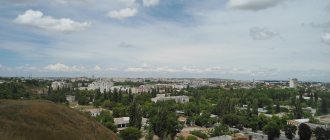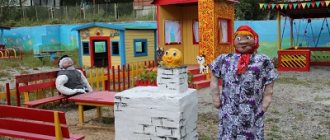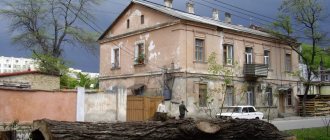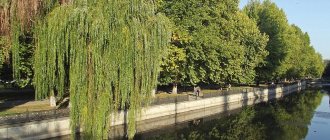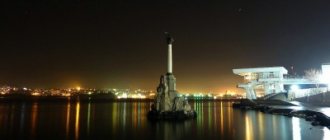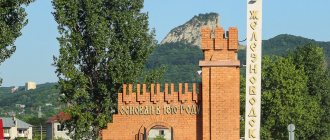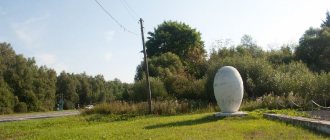In the center of the Crimean peninsula, near the Salgir River, lies the city of Simferopol. This is a picturesque place with many beaches ,
cafes and entertainment centers
.
Simferopol is a city where in a very short period you can visit recreation centers, then go hiking, go to the mountains and visit, for example, the Tavrida Museum or the Peace Square, where the famous monuments of Simferopol are located.
There will be places to go with your child. You can relax with your children in amusement parks and festivals.
In addition, a photo shoot in Simferopol will be a great idea for a blog or personal archive.
History of Simferopol and general information
Simferopol is the capital of Crimea and the origins of its history.
The history of Simferopol has a number of important historical events that influenced not only the culture of the Crimean island, but also the culture of surrounding countries in general.
In the first millennium BC, Greek colonies began to appear in Crimea, inhabited by Scythian and Taurian tribes. As a result of Greek expansion in the fifth century BC. the territory of the peninsula became part of two states.
In the third century BC. The Scythians founded the city of Naples. It is located near modern Simferopol and now in that place there is a historical open-air monument complex, which is open to tourists.
Since the third century, various tribes have invaded Crimea. These tribes destroyed ancient cities, and in the 8th century Crimea was destroyed and it became Byzantine, half of the island belonged to the Khazar Kaganate. Since the 9th century, the Khazars have been supplanting the Rus in the Crimea.
In the 12th century, the Polovtsians appeared here; from the 13th century, Crimea was part of the Golden Horde under the rule of the Tatar-Mongols. By the 15th century, Crimea was divided between khanates and colonies. Crimea then passes to the Ottoman Empire, but subsequently passes to Rus'.
By the 1950s it goes to Ukraine and again to Russia by 2014.
Interesting facts about Simferopol:
- Simferopol was the capital 5 times.
- The clock on the railway tower is wound 9 times a day.
- The oldest tree is 600 years old.
Central Museum of Tavrida
This museum center includes an exhibition dedicated to the history and nature of Crimea. The halls display more than 150 thousand exhibits of the following areas:
- Historical.
- Cultural.
- Natural.
The rich exhibition covers all the important historical events that took place on the Crimean peninsula. Despite the fact that during the war the museum suffered significant damage and some of the collections were lost, many valuable exhibits were still preserved. Now visitors can better understand the history of Crimea.
Location: Gogol street - 14.
How to get to Simferopol?
You can get to it from anywhere in the world, no matter where you are. Simferopol has an airport with international and domestic lines. Ticket prices fluctuate around 2-4 thousand rubles per person when departing from Moscow.
From Simferopol airport you can take a bus or taxi to anywhere in Crimea. The Yandex map will help you find the right route. From Simferopol airport you can immediately approach those standing there without calling a taxi.
There is also a railway station in Simferopol where all trains arrive, so there will be no difficulties with transfers, especially if you made a flight or trip within the country without transfers.
During the trip you can see the nature and beautiful places of the peninsula.
Creators of the fairy tale
5 ways to get from Simferopol airport to Yalta
For more than 50 years, beautiful characters from Russian fairy tales have lived in the park under the oak tree, who can bewitch you in an instant. Everyone can watch these wonderful heroes and few people know their origin and history.
Back in the 50s and 60s, the name of Sergei Carnicola was known to everyone, especially when it came to theatergoers. He was a talented comedian and playwright who performed dozens of roles in world-famous productions.
In addition, Sergei Ivanovich was a participant in the Great Patriotic War, an honored artist and simply a wonderful person. He devoted more than 50 years of his life to the theater, moreover, he was not only an actor, but also a theater designer, as well as a decorator. Already in 1957, he became the author of the very first sketch of a fairy tale corner in a modern park.
How to get from the airport to the city?
Another question is how to get from the airport to the city. If you can get there without problems and transfers, directly from your city, then with intracity trips it is more difficult.
First of all, you need the schedule of minibuses and the ring bus/trolleybus.
Schedule of Sevastopol Routes from the Airport
| Airport | Gurzuf | 05:08, 08:00, 10:00, 12:45 |
| Airport | Evpatoria | 06:10, 07:20, 07:40, 08:02, 08:15, 08:45, 09:30, 09:40, 09:45, 10:00, 10:35, 11:00, 11:05, 11:20, 11:25, 12:10, 12:25, 12:35, 12:55, 13:12, 13:40, 13:45, 13:55, 14:15, 14:35, 14:40, 14:52, 15:20, 16:20, 17:00, 17:20, 17:30, 17:53, 18:20, 18:50, 20:00, 20:05, 20:30, 20:45, 21:15, 21:50 |
| Airport | Kerch | 05:50, 07:45, 08:20, 12:05, 13:35, 15:25, 18:15 |
| Airport | Koktebel | 05:40, 10:55, 18:40 |
| Airport | Resort | 05:40 |
| Airport | Peaceful | 07:40, 11:05, 14:15, 17:30, 20:30 |
| Airport | Miskhor | 15:05 |
| Airport | Marine | 04:40, 09:40, 11:30, 16:37 |
| Airport | Nikolaevka | 07:25, 11:25, 15:15, 19:30 |
| Airport | New World | 13:10, 20:30 |
| Airport | Ordzhonikidze | 06:30 |
| Airport | Parthenite | 09:35, 09:55, 15:05, 17:20, 20:20 |
| Airport | Rybachye | 05:45, 11:02, 14:25, 17:52 |
| Airport | Sevastopol | 04:30, 05:20, 05:40, 05:55, 07:20, 07:30, 07:40, 08:20, 08:40, 09:15, 09:55, 10:15, 10:40, 11:25, 11:30, 11:50, 12:15, 12:25, 12:50, 13:25, 13:55, 14:20, 14:55, 15:30, 16:15, 16:30, 16:45, 17:45, 20:30, 21:00 |
| Airport | Simeiz | 09:00, 13:50, 16:50, 17:20, 18:40, 20-10 |
| Airport | Zander | 04-40, 05:30, 06:10, 06:55, 07:45,09:40, 10-10, 11:20, 11-30, 12:15, 13-45, 14:00, 15:05, 16:15, 16-37, 18:30 |
| Airport | Feodosia | 05-10, 05-40, 05-50, 07-45, 08-00, 08-20, 09:05, 10:10, 10-55, 11:25, 12-05, 12:40, 13-05, 13-35, 13-50, 15:10, 15-25, 16:50, 17-15, 18-15, 18-40, 20:30 |
| Airport | Foros | 15:30 |
| Airport | Black Sea | 06:10, 07:20, 08-15, 09-45, 12:55, 14:40, 17-20, 20:45 |
| Airport | Stormy | 12:35, 20:05 |
| Airport | Shchelkino | 13:50 |
| Airport | Yalta | 05:10, 06:20, 09:00, 09:35, 10:05, 11:30, 12:40, 13:35, 13-50, 14:15, 15-05, 15-20, , 16:24, 16:50, 17:20, 17:40, 18-40, 20-10 |
To get from the airport to the city, you can also use taxis, which operate around the clock.
Tickets for minibuses cost from 300 rubles per person.
Naples Scythian
Naples Scythian in Simferopol is a special reserve, the history of which began in the summer of 2011. Special excursions are organized for visitors. Since October 2015, the protected archaeological complex has been a cultural heritage site of federal significance.
Scythian Naples was one of the most important cities in ancient times in the Crimea and the Scythian state. In order to reveal interesting facets of history, a special reserve was created, which performs several functions at once: security, cultural and educational, scientific and educational.
Location: Arkhaeologicheskaya street - 1.
When to go to Simferopol?
The best time to travel is June and August. It's not the best time to go here in early spring or autumn. You can come to winter resorts in winter and spend the New Year holidays here.
During the cold autumn season, you can visit parks, the city center, and take a walk along the embankment.
February is considered the coldest month in all of Crimea. The temperature there usually does not drop below -5 degrees Celsius.
If you have nevertheless planned your Crimean vacation for the winter, then it is better to go to Yalta or Alushta. From there it is easy to reach the main tourist spots.
Zoo corner
The zoo has been successfully operating in Simferopol since 1958. Initially, it was a small area where chickens, ducks, rabbits and a monkey lived. Subsequently, work was carried out to expand the corner and replenish it, and this was facilitated by active exchange between zoos during the Soviet era.
Currently, the zoo has about three hundred animals of eighty species. The main pride is the lion Baron, which was presented by representatives of the Skazka Zoo from Yalta.
Location: Kirova Avenue street - 51.
Climate and ecology in Simferopol
The climate in Simferopol is hot and dry. Summer lasts from early spring until October, gradually decreasing temperatures from a peak in August to +15 in October.
The climate is foothill and mild continental. Exotic plants easily grow here and rare species of animals live here. This explains the huge number of nature reserves, arboretums and protected parks.
- Winter:
On average, the temperature here is from +1.8 to +15. Rarely does the temperature drop to sub-zero levels.
- Spring:
In Simferopol, unlike Sevastopol, which is closer to the sea, spring begins in March or mid-March. By May, the beach season already opens, but the air temperature still does not rise above +22 degrees.
- Summer:
Summer here is hot and sultry. Basically, the temperature in summer is about 30-33 degrees, although it can reach 40 degrees. The hottest month is August. It was on August 8, 2010 that the highest temperature in Simferopol was recorded - 39.9 degrees.
- Autumn:
Autumn begins in October, so the beach season is not over yet in September. Usually in autumn there is a lot of rain and dampness, especially in the cities of Crimea closer to the Black Sea. In December, frost and primary snow cover appear. But at the beginning of autumn, in September, many even arrange photo sessions in Simferopol. On mountain barge slopes and near the water surface.
Kebir-Jami Mosque
The mosque is a famous architectural monument of Simferopol. In addition, this particular object is the oldest in the city.
The inscription at the entrance proves that the mosque was built back in 1508 . At the same time, in 1740 there was a fire, after which it was possible to restore the religious site. The last time restoration work was carried out was in 1995.
Nowadays, Kebir Jami is the main Friday mosque of the Crimean peninsula. The complex also includes a library of the Crimean Tatars, a madrasah, the residence of the mufti, and the Spiritual Administration of Muslims living in Crimea.
Location: Kurchatova street - 4.
How to get around the city?
To do this, you need a tourist map, which, in addition to routes, also contains places with descriptions.
Regarding transport, you can travel by buses, minibuses and trolleybuses. minibuses run every 20 minutes from the airport, railway station, bus station and city stops. You can travel by checking the schedule, but if you don’t have one, then take three simple steps:
- Find the nearest stop.
- Ask the locals what bus/minibus number goes to the place you need and where to find it.
Most likely, they will tell you either a direct flight or the nearest one with a transfer.
- Waiting for your route around the city.
2 minibuses go every 10 minutes to the city hospital, to Naples - every 20, but already 85. Every 20 minutes the 22 bus goes to the Central Market, but you can also ask to stop 2, 3, 69, 86, 83 and 85. There are also routes from Simferopol to other cities.
Simferopol Art Museum
This museum center is located in a classical palace style building, which was built in 1913. Currently, the collection includes more than nine thousand works of Russian, Ukrainian and Western European art. In the exhibition you can find objects from the 16th century to the present day, but it is noted that there are two large departments (pre-revolutionary and modern).
Every month, the halls host 1–3 thematic exhibitions dedicated to painting, graphics, and decorative and applied arts. It is these events that reveal the amazing facets of the talents of young Crimean artists.
The museum regularly hosts theatrical performances and musical evenings.
Location: Karl Liebknecht street - 35.
Where to live in Simferopol?
There are two options here. You can either live in a hotel or hotel, or rent a room and a house.
But depending on the budget, you have to look at it. For example, the Master and Margarita hotel charges 600 rubles per night for one person, renting a house for the night costs 550 rubles. But there are prices starting with four-digit numbers. For example, some hotels charge from 1 to 15 thousand per night. Perhaps this is due to the fact that in addition to the fact that Simferopol is a resort city, Simferopol is the capital of Crimea.
And yet, in good hotels prices per night start from 2 thousand.
You can rent a room or house from locals for 200-700 rubles per day. If you plan to stay for a long period, you can rent an apartment, but the prices for rent start at 20,000 per month.
The prices, as for Simferopol where there are many resorts and an influx of tourists, can be said to be “divine”. The same prices exist in regular big cities.
I’ll advise you again - when visiting, try to find out everything from the locals, preferably your friends.
Option No. 2
The city of Simferopol is the capital of the Republic of Crimea. It is located in the central part of the Crimean Peninsula. The city is one of the largest in Crimea. Simferopol is the center of economic, cultural and scientific life of the entire peninsula. Translated from Greek, Simferopol means “gathering city”, “worker”. The city was founded in 1984 and is considered relatively young. Many centuries ago, the Tatar village of Ak-Mosque was located in its place. “Gateway of Crimea” is another name of the city, which is due to the fact that all the roads that lead to different parts of the Crimean region intertwine here.
The list of the most famous attractions of Simferopol includes the city of Naples - Scythian, the Kebir Jami Mosque, the Church of Constantine and Helena, the Vorontsov Palace, the building of the Faculty of Foreign Philology, the house of the merchant Chirakhov and the Dintzer mansion. Also in Simferopol there are a number of unique caves that are popular among tourists.
The clock at the railway station is considered the hallmark of the city. They are notable not only for their dimensions, but also for the fact that their dial is decorated with almost all zodiac signs. Many people call this watch mystical. The signs of Taurus, Libra and Virgo are replaced in them by Ophiuchus, Swan and Hounds.
The railway station itself is also shrouded in many secrets and mysteries. Simferopol station has a double. Its almost exact copy is Sochi Station. In addition, the Simferopol city cinema has a double - a cinema in the city of Tver. They were designed by the same architect and built at the same time.
In addition to the Salgir River, there is another river in Simferopol - the Kazanka, which is underground. Local residents say that there was once a bridge across this river on Kazanskaya Street, hence the name of the river. During the construction of the city hall, the river was walled up and since then only a small part of it can be seen on the surface.
Also one of the interesting and unique places in the city is Chokurcha. This place was the site of primitive people. Mammoth bones were also discovered on it, which, apparently, our ancestors ate.
The city is rich in green parks and squares, in which unique southern trees are planted. You can talk about the sights of the city for hours, but it is best to see all its beauties with your own eyes in order to plunge into the mysterious atmosphere of ancient places.
Sights of Simferopol
What to see in Simferopol in one day? We will now try to answer this question, because many people are there only for a couple of days or just passing through. It will still not be possible to view everything in a short time, but we will tell you about the main thing!
Archaeological Reserve of Naples Scythian
Naples is a city formed by the Scythian tribes, later displaced, not far from modern Simferopol. It is considered the ancestral city of the capital. The population was, by the standards of those times, very decent, namely 2-3 thousand people. With an area of 20 hectares, the city contained a fortress and the settlement itself.
This is one of the open-air museums of Simferopol. Many minibuses, including 85, go to it. This is incredibly exciting for both adults and children.
Drama Theater of Simferopol
For more than 200 years, the Maxim Gorky Drama Theater has been operating in Crimea and delights not only with performances in Crimea, but also with numerous tours of the group.
It was founded by a Simferopol merchant in 1821, who lived in Simferopol on the advice of a doctor. He was an avid theatergoer and decided to open a theater, which would later become the oldest in the south of Russia, in addition, it would become one of the best theaters.
Holy Trinity Monastery
The church was built in the 18th century and rebuilt in the 19th into a more spacious and modern one by those standards. This is one of the main pilgrimage points of the city of Simferopol.
In 1933, the authorities wanted to convert the church into a children's boarding school, but local residents, many of whom were Greek citizens, objected and the authorities had to behave politically correct.
Among the relics there are the relics of St. Luke and the icon of the Virgin Mary.
The church itself is designed in Greek style and has a light drum in the center.
Central Museum of Tavrida
At the end of the 19th century, the scientific commission created the 7th meeting, at which the formation of the Tauride Museum was established.
This museum was developed with the goal of permanently storing valuable historical papers and artifacts in one place. By now, the museum has more than 100 thousand exhibits, among which there are ancient archaeological finds and important historical papers.
The museum is located at the address: Crimea Simferopol, Bondarny Lane 2.
Prices: from 60 to 300 rubles.
Gagarinsky Park in Simferopol
In the sixties of the last century, the wetland in the center of Simferopol was drained and a park with an area of 50 hectares was laid out in that place. – this is the park named after Gagarin and Simferopol began to breathe.
The park is considered the largest in Crimea and is not only a place of recreation, but a real attraction.
The park has ponds, birds and a large number of squirrels. Places for recreation and water and entertainment.
Peter and Paul Cathedral in Simferopol
At the end of the 19th century, at the expense of Simferopol residents, the Peter and Paul Cathedral was rebuilt, which later became one of the most famous cathedrals in Simferopol.
The incredibly beautiful cathedral, painted inside on all the walls and arches, was closed and converted into a warehouse, and several decades before that, the dilapidated one was disbanded and was almost inactive.
They began to restore the cathedral again in the 80s, when it started working again. Now prayers, services and lethargy are held there.
Simferopol railway station
The capital of Crimea, Simferopol, has a large railway station, the junction of which is one of the key ones.
The construction of the Lozovo-Sevastopol railway was opened in 1871. It was built to facilitate the movement of troops and the movement of provisions in wartime, and its absence made all this difficult during the Crimean War. In addition, considerable trade turnover passed through such large cities.
The work of the railway slowed down greatly in 2014, during the annexation of Crimea to Russia. After the construction of the Crimean Bridge was completed, the work of the railway resumed.
Botanical Garden of Simferopol
Salgirka, Vorontsovka, Botanical Garden - these are all the names of one of the gardens in Simferopol. Rare plants and alleys of flowers of different varieties grow there. You can also find exotic specimens more than 100 years old there.
The Vernadsky Botanical Garden is an historical and natural reserve created in 2004.
The garden is open to the public from 7 to 7. But you need to be as careful as possible, since you will be fined for picking flowers or damaging plants.
Alexander Nevsky Cathedral
The main Christian cathedral of Simferopol, made in the style of classicism, as evidenced by the columns and triangular arch, which are not typical for churches.
The temple has survived many tests of time. Its construction was hampered from the very beginning by the death of the Empress and the First World War. Then the temple was built, but in the 1930s it was undermined and restored only at the beginning of the 21st century.
Now prayer services are held there.
Simferopol Zoo
The zoo is located in the center of Simferopol and is the most visited attraction. Located at the intersection of Kievskaya and Kirov. The zoo has over 320 species. You can play with some domesticated animals in a special area. Routes 21, 51, 52, 54 and 55 go to the zoo. ticket price from 100 to 200 rubles.
Art Museum of Simferopol
Its history began as an art gallery, which later grew into the oldest museum in Crimea.
In 1937, like most significant buildings, it was reorganized and temporarily moved to Pushkin Street. During the Second World War, during the Luftwaffe attack and transportation through Kerch, most of the collection’s exhibits burned down.
Now the oldest museum in Simferopol is located on the street. Dolgorukovskaya 35. Ticket price from 100 to 200 rubles.
Musical Theater of the Republic of Crimea
On Lenin Square there is a theater of the Republic of Crimea, transferred there in 1995. Plays, dramas and productions, as well as premieres, are held there.
It was the best musical theater building in the Ukrainian SSR.
Church of All Saints in Simferopol
The temple is already more than 150 years old, but it is unique not even for this, but for the fact that during its entire existence it has never been abolished or reorganized.
It was built by the merchant Maslennikov and all this time he was engaged in the burial of clergy. Next to it there is a cemetery where the relics of St. Bishop Michael of Tauride are buried.
Country house of Count Vorontsov
Initially, it, like many other now architectural values, was bought by the landowner Naryshkina and from that moment perestroika began.
The building is located on the territory of the park at the address Yalta building 2 and has the second name “little palace”.
Kebir Jami Cathedral Mosque
It was founded in 1508 and is therefore the oldest building in Simferopol. This Mosque is the main Friday mosque for Muslims in Simferopol.
Located at Kurchatova Street.
Crimean Ethnographic Museum
Initially it was planned as a branch of the Central Taurida Museum. It was a shelter for orphan girls, and a century later, a historical museum was organized there, which eventually became independent.
Ticket prices are 200 and 150 rubles. Adult and child respectively.
Karaite Kenassa
Such an architectural value was built at the expense of the Karaites themselves with the permission of the Tauride Administration. At first, the Karaite community was located in a private house, but over time, having acquired finances, they began building on this architectural monument of the late 19th century.
Now the building is in a state of restoration, but still houses a religious community.
Catherine Park in Simferopol
The park has quite an interesting history. It was founded on a landfill site. The fact is that the smell from it spread to the city and the governor who lived nearby tried to convert it into a park, but in the event of the First World War, construction was suspended, but was soon resumed and after the park was renamed Ekaterininsky.
Chokurcha Cave
A natural cave 40-45 thousand years old. These are the oldest caves and the only witnesses of the Paleolithic in Simferopol.
Depth and width are 5 and 7 meters respectively. Care is fenced and paid, since the cave is a nature reserve.
Victory Square
The square is located in the city center and has changed many names throughout its history. At first it was not planted, but after landing it was named after the cathedral located there - Cathedral. In Soviet times it was named Komsomolsky and Pionersky.
Now, in Victory Park there is a monument to the T-34 tank and there is also a memorial to soldiers.
Temple of Constantine and Helena
This is the place of visit and prayer service of Empress Catherine II. It was destroyed in Soviet times to the very foundation, leaving only the arch. In the 90s, it was decided to restore the religious, historical and cultural monument that Irina currently operates.
Oak Bogatyr of Tavrida
For more than 600 years, the oak tree has been growing on this territory of Simferopol. The height of the oak tree reached 30 meters.
The botanical monument received its status in the 70s and is a frequent destination for tourists.
Square 200th anniversary of Simferopol park of forged figures
In 2007, local metalsmiths began installing their works in the park.
Previously there was a park and a hotel nearby. The “European” hotel also served as a warehouse for Red Army soldiers and was blown up by the Germans; the first elevator in Simferopol was installed there.
Water tower in Simferopol
The water tower does not initially sell any idea of its purpose by its appearance. But this is the most ordinary tower for providing Simferopol residents with water, distinguished by its incredible architecture.
According to legend, the Emir of Bukhara allocated funds for its construction.
Milhausen's house
In the depths of Kievskaya Street, among high-rise buildings, there is an old estate, which has been rebuilt into 6 apartments.
Previously, this was the country estate of the famous doctor Fyodor Karlovich. He was a respected man and many wanted to make acquaintance with him when they arrived in Simferopol, for example, Aivazovsky visited there.
Marble Cave
An incredibly beautiful cave with shimmering light and stalactites. The path along it leads along light marble corridors.
The ticket price now ranges from 500 to 600 rubles. You can even do it with kids.
Emine Bair Khosar
Below the marble cave in Chatyr-Dag there is another one. This cave is washout, which means that the waters gradually washed away the rock and formed the cave. There are also stalactites and growths. The bottom is sometimes flooded with water.
The cave is a nature reserve as it contains many mineral fossils and remains such as those from the Ice Age.
Prices also range from 500 to 700 rubles.
Red Cave
27 kilometers and more than 2 million years, a natural cave with a unique microflora was formed.
There are stalactites, lakes with crystal clear water, waterfalls and rock galleries.
Tours are organized there and even with a wetsuit. Prices from 300 to 600 rubles, opening hours from 9 to 7.
Eski Saray Mosque
An ancient palace-mosque. The ruins of the walls examined by archaeologists indicate that previously there was a dome there, which has not survived to this day.
The walls were preserved to prevent further destruction.
Weeping Rock
The rocks along which water flows are located in the reserve, which is equipped with everything necessary for relaxation.
There is cool, clean water that has been flowing for decades. Alleys, ponds and lakes were also formed there.
Karaite kenasa
Crimea is one of the habitats of a small people - the Karaites. In everyday life, being close to the Turks, they, however, profess a special branch of Judaism. Karaite houses of worship are called kenasa (accent on the last syllable). They are found in several Crimean cities, but Simferopol is considered the most beautiful. This kenasa was built at the end of the 19th century, next to the former prayer house, which could no longer accommodate the growing Karaite community. The beautiful building, combining elements of Byzantine, Moorish and Gothic architectural styles, was built with funds raised by the community.
With the establishment of Soviet power, the Karaite community in 1922 signed an agreement with the local branch of the NKVD on the unhindered use of kenasa. Since 1930, the diminished religious community could no longer support the kenasa. At her suggestion, a Karaite club functioned in the building for three years. Since 1936, the building was transferred to the Crimean Television and Radio Center. At the same time, the building was deprived of cult attributes: in particular, the six-pointed star was replaced by a five-pointed one.
Since 1979, the building received the protected status of an architectural monument. In post-Soviet times, the building was returned to the Karaite religious community. After the annexation of Crimea to Russia, a partial restoration of the kenasa was carried out.
Karaite kenasa
Address: st. Karaimskaya, 6. Directions: minibuses No. 57 and 78 to the stop “Ul. Sergeev-Tsensky".
Where to go for one day from Simferopol
Cinemapark Viking
A cultural and historical park of the Viking Age has been created not far from the valley of the Red Caves.
There you can visit blacksmiths, towers, bars, houses, an armory and a medieval market. It will be possible to watch and participate in the battle against the siege from any age.
Ticket prices: under 5 years old – free, under 14 – 450, older – 650.
The park is located outside the city, not far from the village of Perevalnoye along the Simferopol - Alushta highway. The tour lasts 1.5 hours, and after that you can go to the Honey House restaurant. In the same park you can try archery and sporting weapons.
Pets and birds run nearby. They are accustomed to humans and are not afraid of them. You can pet them and feed them.
On site you can buy amulets and souvenirs of real Vikings and listen to the mythology of this people.
Holy surgeon
Crimeans and Simferopol residents are rightfully proud of their outstanding fellow countryman, known in religious circles as St. Luke. From 1946 until his death in 1961, he headed the city Cathedral with the rank of Archbishop of Crimea. Luke was one of those rare clergy who fully fulfilled the commandments of Christ. All his life he selflessly helped the poorest and most vulnerable people, not differing too much from them in his modest attire. He recognized the authority of Christ alone and was principled and independent in his judgments and actions. In pre-war Soviet times, the future archbishop was repeatedly arrested and spent 11 years in exile. It would seem that this was a fairly common fate of a priest during the Soviet period.
Saint Luke
Valentin Voino-Yasenetsky is an outstanding Soviet surgeon, one of the founders of Soviet purulent surgery, Doctor of Medical Sciences, Stalin Prize laureate (the only clergyman).
At the beginning of the war, Voino-Yasenetsky from Krasnoyarsk exile sent a telegram addressed to Kalinin offering the Red Army his services as a highly qualified surgeon. The request to temporarily interrupt the exile was granted, and Voino-Yasenetsky, appointed chief surgeon of the Krasnoyarsk evacuation hospital, saved many wounded Soviet soldiers. And in 1942 the church authorities entrusted Bishop Luke with the leadership of the Krasnoyarsk diocese.
After the military hospital moved to Tambov in 1944, Doctor Voino-Yasenetsky continued his active medical work, at the same time heading the local diocese of the Russian Orthodox Church. Under his leadership, about a million rubles were collected and transferred to the needs of the front. In 1946, the archbishop, who had not fully served his exile, became a laureate of the Stalin Prize of the first degree for the development during the war of innovative methods of surgical treatment of purulent wounds. He donated two-thirds of the prize, which was huge at that time, to post-war orphanages that were in dire need of it.
After his death, the archbishop was canonized by the Ukrainian Orthodox Church in 1995. And the Russian Orthodox Church canonized its bishop as a new martyr and confessor in 2000. Krasnoyarsk Medical University bears his name. In 2013, a feature film “Cure Fear” was shot about Luka Krymsky. In 2015, the documentary film “Healer Luke” was shown on Channel One. In the Holy Trinity Cathedral of Simferopol, where the bishop served, there is a small museum of his (see below).
Anatomy Museum
The Anatomy Museum was created on the basis of the Georgievsky Medical University back in 1931. Currently, the institution attracts with the following opportunities for cultural knowledge:
- An exhibition revealing the features of the human skeleton and internal organs.
- Exhibition of deformities.
- Kunstkamera, which includes 1200 exhibits .
In the corridors of the museum you can see paintings dedicated to the famous surgeon N. I. Pirogov, who worked in the building of the museum center during the Crimean War.
The Anatomy Museum is included in the UNESCO list of protected sites.
Location: Alexander Nevsky Avenue-27A.
Manor of Countess Montgenet
The estate surprises with its unique architecture. Russian landowner Vasily Gnutov sold his estate to the Mongenet family, who gave the house a luxurious appearance. During World War II the building was damaged and fell into disrepair. Currently, only a few surviving parts can be seen:
- Some walls facing outwards.
- 3-storey tower outbuilding.
- The main staircase.
- The pool left over from the fountain.
The interior of the castle was destroyed and covered with ordinary debris. Thus, only a reminder remains of the estate. At the same time, the Manor of Countess Montgenet remains a landmark that connects modern days with echoes of the 19th century. In addition, a particle of France is also found in Crimea.
Location: Pionerskoe.
Wolf Grotto Baryu-Teshik
Wolf Grotto Baryu-Teshik is an archaeological monument of Crimea. Excavations were carried out on the site in front of the grotto in the 1970s, during which it was possible to find tools of labor and hunting from the Paleolithic era ( 40,000 years ago ), bones of a bear, mammoth and deer, and special stone partitions for protection from the wind.
The grotto is located 12 kilometers from Simferopol on the banks of the Beshterek River. The location leads to constant cold winds, so this area could not have been a permanent site for Paleolithic people. Nowadays, tourists can visit the grotto, but must take care of warm clothing.
Location: Mazanka.
